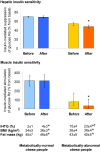Hepatic Steatosis as a Marker of Metabolic Dysfunction
- PMID: 26102213
- PMCID: PMC4488828
- DOI: 10.3390/nu7064995
Hepatic Steatosis as a Marker of Metabolic Dysfunction
Abstract
Nonalcoholic fatty liver disease (NAFLD) is the liver manifestation of the complex metabolic derangements associated with obesity. NAFLD is characterized by excessive deposition of fat in the liver (steatosis) and develops when hepatic fatty acid availability from plasma and de novo synthesis exceeds hepatic fatty acid disposal by oxidation and triglyceride export. Hepatic steatosis is therefore the biochemical result of an imbalance between complex pathways of lipid metabolism, and is associated with an array of adverse changes in glucose, fatty acid, and lipoprotein metabolism across all tissues of the body. Intrahepatic triglyceride (IHTG) content is therefore a very good marker (and in some cases may be the cause) of the presence and the degree of multiple-organ metabolic dysfunction. These metabolic abnormalities are likely responsible for many cardiometabolic risk factors associated with NAFLD, such as insulin resistance, type 2 diabetes mellitus, and dyslipidemia. Understanding the factors involved in the pathogenesis and pathophysiology of NAFLD will lead to a better understanding of the mechanisms responsible for the metabolic complications of obesity, and hopefully to the discovery of novel effective treatments for their reversal.
Keywords: NAFLD; VLDL secretion; fatty acid metabolism; glucose metabolism; insulin resistance; lipid metabolism; lipolysis; liver steatosis; nonalcoholic fatty liver disease; obesity.
Figures


References
Publication types
MeSH terms
Substances
LinkOut - more resources
Full Text Sources
Other Literature Sources
Medical

